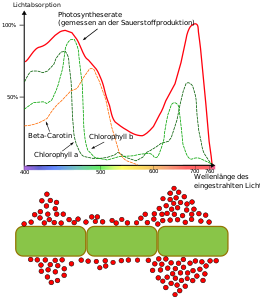Engelmann bacteria experiment
The engelmannsche bacteria test (after Theodor Wilhelm Engelmann ) serves the light-dependent oxygen evolution in oxygenic photosynthesis in different areas of the light spectrum to quantify about.
For this purpose Engelmann directed a beam of light through a prism and projected the resulting light spectrum onto a thin algae thread that was in an aqueous medium that contained bacteria that react positively chemotactically to oxygen. Depending on the color of the light that hit the algae thread (from long-wave red to orange, yellow, green and blue to short-wave violet ), the photosynthetic system contained in the chloroplasts produced more or less oxygen, which the bacteria attacked more or less strongly accumulated in the relevant places. He took the amount of accumulated bacteria as an approximate measure of the rate of photosynthesis, which corresponds to the rate of oxygen production.
The result clearly shows that the optimum areas for photosynthesis lie in long-wave red and short-wave blue, in between, in the area of green and yellow, the photosynthesis rate is lower. This area is known as the green gap . This goes roughly parallel with the absorption maxima of the photosynthetic pigments (see graphic).
The green color of plants can also be explained by the absorption maxima of the photosynthetic pigments: While the red and blue light are almost completely absorbed, the green and yellow light are remitted or transmitted.
literature
- Elmar Weiler, Lutz Nover; Founded by Wilhelm Nultsch: General and molecular botany . Thieme, Stuttgart 2008, ISBN 978-3-13-147661-6 .
Web links
- Engelmann bacteria experiment (animation on YouTube)
